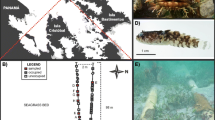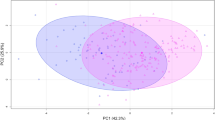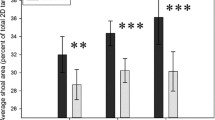Abstract
How vocal organisms share acoustic space has primarily received attention in terrestrial environments. Comparable studies in marine environments, however, remain rare. By recording sounds on a coral reef in French Polynesia for 48 h and 24 h, this study provides first insights on how different sound types are distributed within the acoustic space and may create acoustic niches optimizing acoustic communication within a highly diverse community containing numerous soniferous fish species. Day-time was dominated by two to six sound types, while recordings performed at night revealed a more diverse vocal community made of up to nineteen sound types. Calling activity was distributed over time allowing each sound type to dominate the soundscape sequentially. Additionally, differences in the acoustic features of sounds occurring during the same period were observed. Such partitioning in time and acoustic spaces would reduce potential overlaps of sounds produced by vocal species living in sympatry in coral reefs.



Similar content being viewed by others
References
Allen G, Werner T (2002) Coral reef fish assessment in the ‘coral triangle’ of southeastern Asia. Environ Biol Fish 65:202–214
Amorim MCP (2006) Diversity in sound production in fish. In: Ladich F, Collin SP, Moller P, Kapoor BG (eds) Communication in fishes. Science Publishers, Enfield, pp 71–105
Bacchet P, Zysman T, Lefèvre Y (2006) Guide des poissons de Tahiti et ses îles, 4th edn. Au vent des îles éditions, Tahiti
Bellwood DR, Wainwright PC (2002) The history and biogeography of fishes on coral reefs. In: Sale PF (ed) Coral reef fishes. Dynamics and diversity in a complex ecosystem. Academic Press, San Diego, pp 5–32
Bertucci F, Lejeune P, Payrot J, Parmentier E (2015) Sound production by dusky grouper Epinephelus marginatus at spawning aggregation sites. J Fish Biol 87:400–421
Bertucci F, Parmentier E, Lecellier G, Hawkins AD, Lecchini D (2016) Acoustic indices provide information on the status of coral reefs: an example from Moorea Island in the South Pacific. Sci Rep 6:33326
Bertucci F, Parmentier E, Berthe C, Besson M, Aubin T, Hawkins AD, Lecchini D (2017) Snapshot recording provide a first description of the acoustic signatures of deeper habitats adjacent to coral reefs of Moorea. PeerJ 5:e4019
Bignotte-Giró I, López-Iborra GM (2018) Acoustic niche partitioning in five Cuban frogs of the genus Eleutherodactylus. Amphibia Reptilia 40(1):1–11
Brumm H (2006) Signalling through acoustic windows: nightingales avoid interspecific competition by short-term adjustment of song timing. J Comp Physiol A 192(12):1279–1285
Brumm H, Voss K, Köllmer I, Todt D (2004) Acoustic communication in noise: regulation of call characteristics in a New World monkey. J Exp Biol 207(3):443–448
Carriço R, Silva MA, Menezes GM, Fonseca PJ, Amorim MCP (2019) Characterization of the acoustic community of vocal fishes in the Azores. Peer J 7:e7772
Chase JM, Leibold MA (2003) Ecological niche: linking classical and contemporary approaches. The University of Chicago Press, Chicago
Farina A, James P (2016) The acoustic communities: definition, description and ecological role. Biosystems 147:11–20
Fine ML, Winn HE, Olla BL (1977) Communication in fishes. In: Sebeok TA (ed) How animals communicate. Indiana University Press, Bloomington, pp 472–518
Galzin R, Lecchini D, Lison de Loma T, Moritz C, Parravicini V, Siu G (2016) Long term monitoring of coral and fish assemblages (1983–2014) in Tiahura reefs, Moorea, French Polynesia. Cybium 40:31–41
Grafe T (1996) The function of call alternation in the African reed frog (Hyperolius marmoratus): Precise call timing prevents auditory masking. Behav Ecol Sociobiol 38:149–158
Hastings PA, Širović A (2015) Soundscapes offer unique opportunities for studies of fish communities. Proc Natl Acad Sci 112(19):5866–5867
Jublier N, Bertucci F, Kéver L, Colleye O, Ballesta L, Nemeth RS, Lecchini D, Rhodes KL, Parmentier E (2020) Passive monitoring of phenological acoustic patterns reveals the sound of the camouflage grouper, Epinephelus polyphekadion. Aquat Conserv Mar Freshw Ecosyst 30(1):42–52
Krause BL (1993) The niche hypothesis: a virtual symphony of animal sounds, the origins of musical expression and the health of habitats. Soundscape Newslett 6:6–10
Krause BL (2002) Wild soundscapes: discovering the voice of the natural world. Wild Sanctuary Books, Berkeley
Lima MSCS, Pederassi J, Pineschi RB, Barbosa DBS (2019) Acoustic niche partitioning in an anuran community from the municipality of Floriano, Piauí, Brazil. Brazil J Biol 79(4):566–576
Lobel PS, Kaatz IM, Rice AN (2010) Acoustical behavior of coral reef fishes. In: Cole KS (ed) Reproduction and sexuality in marine fishes: patterns and processes. University of California Press, Oakland, pp 307–386
Lobel PS (2013) In: Lang MA, Sayer M (eds) Joint international scientific diving symposium AAUS & ESDP, Curaçao, pp 179–184
Luczkovich JJ, Mann DA, Rountree RA (2008) Passive acoustics as a tool in fisheries: an introduction to the American Fisheries Society Symposium. Trans Am Fish Soc 137:533–541
Luther D (2009) The influence of the acoustic community on songs of birds in a neotropical rain forest. Behav Ecol 20(4):864–871
Miller J (1982) Divided attention: evidence for coactivation with redundant signals. Cognit Psychol 14(2):247–279
Mossbridge JA, Thomas JA (1999) An “acoustic niche” for Antarctic killer whale and leopard seal sounds. Mar Mam Sci 15(4):1351–1357
Mouy X, Rountree R, Juanes F, Dosso SE (2018) Cataloging fish sounds in the wild using combined acoustic and video recordings. J Acoust Soc Am 143:EL333
Mullet TC, Farina A, Gage SH (2017) The acoustic habitat hypothesis: an ecoacoustics perspective on species habitat selection. Biosemiotics 10:319–336
Myrberg AA (1981) Sound communication and interception in fishes. In: Tavolga W, Popper AN, Fay RR (eds) Hearing and sound communication in fishes. Springer, New York, pp 395–426
Naugler CT, Ratcliffe L (1994) Character release in bird song: a test of the acoustic competition hypothesis using American Tree Sparrows Spizella arborea. J Avian Biol 25(2):142–148
Parmentier E, Vandewalle P, Brié C, Diranths L, Lecchini D (2011) Comparative study on sound production in different Holocentridae species. Front Zool 8:1–12
Parmentier E, Lecchini D, Mann D (2016) Sound production in damselfishes. In: Parmentier E, Frédérich B (eds) Biology of damselfishes. CRC Press, New York, pp 204–228
Parmentier E, Raick X, Lecchini D, Boyle KS, Van Wassenbergh S, Bertucci F, Kever L (2017) Unusual sound production mechanism in the triggerfish Rhinecanthus aculeatus (Balistidae). J Exp Biol 220:186–193
Parmentier E, Solagna L, Bertucci F, Fine ML, Nakae M, Compère P, Smeets S, Raick X, Lecchini D (2019) Simultaneous production of two kinds of sounds in relation with sonic mechanism in the boxfish Ostracion meleagris and O. cubicus. Sci Rep 9:4962
Parsons MJ, Salgado Kent CP, Recalde-Salas A, McCauley RD (2016) Fish choruses off Port Hedland, Western Australia. Bioacoustics 26(2):135–152
Planqué R, Slabbekoorn H (2008) Spectral overlap in songs and temporal avoidance in a Peruvian bird assemblage. Ethology 114(3):262–271
Rice AN, Soldevilla MS, Quinlan JA (2017) Nocturnal patterns in fish chorusing off the coasts of Georgia and eastern Florida. Bull Mar Sci 93(2):455–474
Römer H (2020) Insect acoustic communication: the role of transmission channel and the sensory system and brain of receivers. Funct Ecol 34(2):310–321
Rountree RA, Gilmore RG, Goudey CA, Hawkins AD, Luczkovich J, Mann D (2006) Listening to fish: applications of passive acoustics to fisheries science. Fisheries 31:433–446
Ruppé L, Clément G, Herrel A, Ballesta L, Décamps T, Kéver L, Parmentier E (2015) Environmental constraints drive the partitioning of the soundscape in fishes. Proc Natl Acad Sci 112(19):6092–6097
Staaterman E, Rice AN, Mann DA, Paris CB (2013) Soundscapes from a Tropical Eastern Pacific reef and a Caribbean Sea reef. Coral Reefs 32(2):553–557
Schmidt AK, Balakrishnan R (2015) Ecology of acoustic signalling and the problem of masking interference in insects. J Comp Physiol A 201(1):133–142
Schmidt AK, Römer H (2011) Solutions to the cocktail party problem in insects: selective filters, spatial release from masking and gain control in tropical crickets. PLoS ONE 6(12):e28593
Schmidt AKD, Römer H, Riede K (2013) Spectral niche segregation and community organization in a tropical cricket assemblage. Behav Ecol 24(2):470–480
Shieh BS, Liang SH, Chiu YW (2015) Acoustic and temporal partitioning of cicada assemblages in city and mountain environments. PLoS ONE 10(1):e0116794
Sinsch U, Lümkemann K, Rosar K, Schwarz C, Dehling JM (2012) Acoustic niche partitioning in an anuran community inhabiting an Afromontane wetland (Butare, Rwanda). Afr Zool 47(1):60–73
Siu G, Bacchet P, Bernardi G, Brooks AJ, Carlot J, Causse R, Claudet J, Clua E, Delrieu-Trottin E, Espiau B, Harmelin-Vivien M, Keith P, Lecchini D, Madi-Moussa R, Parravicini V, Planes S, Ponsonnet C, Randall JE, Sasal P, Taquet M, Williams JT, Galzin R (2017) Shore fishes of French Polynesia. Cybium 41(3):245–278
Stone E (2015) Separating the noise from the noise: a finding in support of the “Niche Hypothesis,” that birds are influenced by human-induced noise in natural habitats. Anthrozoös 13(4):225–231
Sueur J, Krause B, Farina A (2019) Climate change is breaking Earth’beat. Trends Ecol Evol 34(11):971–973
Tavolga WN, Popper AN, Fay RR (2012) Hearing and sound communication in fishes. Springer, New York
Thorson RF, Fine ML (2002) Acoustic competition in the gulf toadfish Opsanus beta: acoustic tagging. J Acoust Soc Am 111(5):2302–2307
Tobias JA, Planqué R, Cram DL, Seddon N (2014) Species interactions and the structure of complex communication networks. Proc Natl Acad Sci 111(3):1020–1025
Tricas T, Boyle K (2014) Acoustic behaviors in Hawaiian coral reef fish communities. Mar Ecol Prog Ser 511:1–16
Vokurková J, Motombi F, Ferenc M, Hořák D, Sedláček O (2018) Seasonality of vocal activity of a bird community in an Afrotropical lowland rain forest. J Trop Ecol 34(1):53–64
Acknowledgements
We thank CRIOBE staff for the help in the positioning of the recorder. We would also like to thank Stuart Sandin and four anonymous reviewers for their constructive comments and suggestions on previous versions of this manuscript.
Funding
This work was funded by different research grants: Total Foundation, Contrat de Projet Etat-Polynésie française 2015–2020, PSL project Pesticor, PSL project Ecora, Agence de l’eau-Rhone Méditerranée Corse—no 2018 1765 and LabEx Corail project EMuL.
Author information
Authors and Affiliations
Contributions
FB, DL and EP designed the study. FB, CB, MB, ASG, XR, and FL collected the data. KM and FB analysed the data. All authors wrote and revised the manuscript. All authors gave final approval for publication.
Corresponding author
Ethics declarations
Conflict of interest
All authors declare they have no conflict of interest.
Ethical approval
This article does not contain any studies with human participants or animals performed by any of the authors.
Additional information
Communicated by Stuart Sandin.
Electronic supplementary material
Below is the link to the electronic supplementary material.
Rights and permissions
About this article
Cite this article
Bertucci, F., Maratrat, K., Berthe, C. et al. Local sonic activity reveals potential partitioning in a coral reef fish community. Oecologia 193, 125–134 (2020). https://doi.org/10.1007/s00442-020-04647-3
Received:
Accepted:
Published:
Issue Date:
DOI: https://doi.org/10.1007/s00442-020-04647-3




